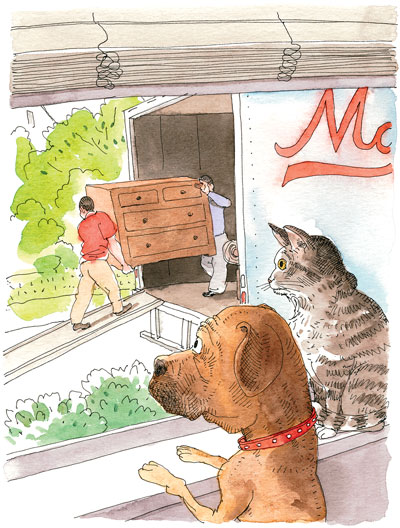
Weeks before Casey Redmon moved out of her apartment on DC’s V Street, Northwest, the unit was being shown to potential buyers. Meanwhile, she was packing up her things.
Her two cats, Amira and Farah, sensed something was up. Amira began binge-eating dry food. Farah often hid and couldn’t be found. Both began knocking over their dishes, scattering food over the floor.
Yody Blass, director of Companion Animal Behavior in Leesburg, says it isn’t uncommon for pets, especially cats, to behave this way before a move. When their worlds are upended, they can get frightened. But pet owners can take steps to ease that anxiety.
While both cats and dogs can become anxious about moves, they do so in different ways. “Cats don’t like change,” Blass says, so the best way to keep a cat calm through the process is to keep the change hidden. Blass suggests putting a cat in a quiet, untouched room while packing and moving the rest of the furnishings. “You can maybe put a little radio on to drown out voices and noises it might not be familiar with,” she says.
When you get to the new place, put the cat in a room and close the door. Let the animal acclimate to that space for a few days before opening the door and letting it explore. This method creates a safe place for the cat to return to.
Marsha R. Reich, owner of Maryland-Virginia Veterinary Behavioral Consulting, says a dog can be just as frightened of change. Many dogs suffer from separation anxiety and can become destructive or loud and may begin relieving themselves in inappropriate places.
Moving heightens this behavior. “Most of these dogs know exactly what it means when the suitcase comes out,” Dr. Reich says, and they don’t like their routines thrown off. She suggests a long-lasting food toy to keep the dog distracted or perhaps a pheromone collar, which contains a calming pheromone that mimics one released by a nursing mother. If possible, take the animal to the new neighborhood and allow it to walk around and become familiar with the terrain.
Before setting up any other furniture, prepare a spot for the dog in the new house. It helps if it includes objects the dog already likes. “Say the dog enjoys sleeping on XYZ sofa,” Reich says. “Don’t ditch that sofa. Or if you ditch the sofa, keep the cushions.”
It might also help to keep a dog in daycare on the day of the move.
One more tip, says Blass: Once you’ve relocated, don’t forget to change your pet’s collar tag, because if the animal gets out of the new place, it won’t know the way home.
See Also:
Smooth Moves: What to Know Before Hiring a Moving Company
Smooth Moves: 16 Top Moving Companies
This article appears in the January 2013 issue of The Washingtonian.

















